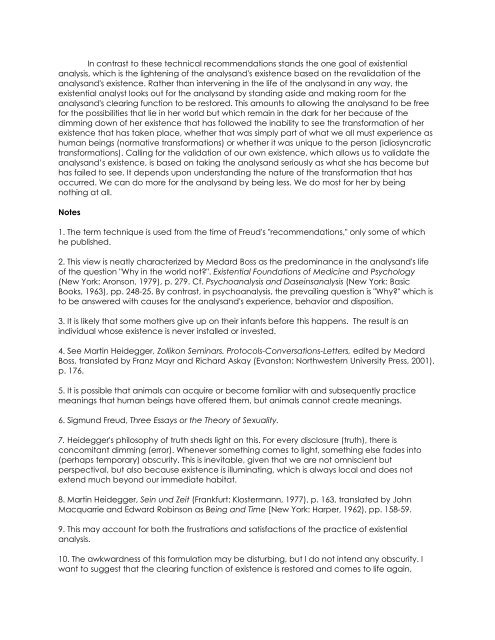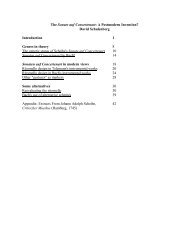SEVEN PAPERS ON EXISTENTIAL ANALYSIS ... - Wagner College
SEVEN PAPERS ON EXISTENTIAL ANALYSIS ... - Wagner College
SEVEN PAPERS ON EXISTENTIAL ANALYSIS ... - Wagner College
You also want an ePaper? Increase the reach of your titles
YUMPU automatically turns print PDFs into web optimized ePapers that Google loves.
In contrast to these technical recommendations stands the one goal of existential<br />
analysis, which is the lightening of the analysand's existence based on the revalidation of the<br />
analysand's existence. Rather than intervening in the life of the analysand in any way, the<br />
existential analyst looks out for the analysand by standing aside and making room for the<br />
analysand's clearing function to be restored. This amounts to allowing the analysand to be free<br />
for the possibilities that lie in her world but which remain in the dark for her because of the<br />
dimming down of her existence that has followed the inability to see the transformation of her<br />
existence that has taken place, whether that was simply part of what we all must experience as<br />
human beings (normative transformations) or whether it was unique to the person (idiosyncratic<br />
transformations). Calling for the validation of our own existence, which allows us to validate the<br />
analysand’s existence, is based on taking the analysand seriously as what she has become but<br />
has failed to see. It depends upon understanding the nature of the transformation that has<br />
occurred. We can do more for the analysand by being less. We do most for her by being<br />
nothing at all.<br />
Notes<br />
1. The term technique is used from the time of Freud's "recommendations," only some of which<br />
he published.<br />
2. This view is neatly characterized by Medard Boss as the predominance in the analysand's life<br />
of the question "Why in the world not?". Existential Foundations of Medicine and Psychology<br />
(New York: Aronson, 1979), p. 279. Cf. Psychoanalysis and Daseinsanalysis (New York: Basic<br />
Books, 1963), pp. 248-25. By contrast, in psychoanalysis, the prevailing question is "Why?" which is<br />
to be answered with causes for the analysand's experience, behavior and disposition.<br />
3. It is likely that some mothers give up on their infants before this happens. The result is an<br />
individual whose existence is never installed or invested.<br />
4. See Martin Heidegger, Zollikon Seminars. Protocols-Conversations-Letters, edited by Medard<br />
Boss, translated by Franz Mayr and Richard Askay (Evanston: Northwestern University Press, 2001),<br />
p. 176.<br />
5. It is possible that animals can acquire or become familiar with and subsequently practice<br />
meanings that human beings have offered them, but animals cannot create meanings.<br />
6. Sigmund Freud, Three Essays or the Theory of Sexuality.<br />
7. Heidegger's philosophy of truth sheds light on this. For every disclosure (truth), there is<br />
concomitant dimming (error). Whenever something comes to light, something else fades into<br />
(perhaps temporary) obscurity. This is inevitable, given that we are not omniscient but<br />
perspectival, but also because existence is illuminating, which is always local and does not<br />
extend much beyond our immediate habitat.<br />
8. Martin Heidegger, Sein und Zeit (Frankfurt: Klostermann, 1977), p. 163, translated by John<br />
Macquarrie and Edward Robinson as Being and Time [New York: Harper, 1962), pp. 158-59.<br />
9. This may account for both the frustrations and satisfactions of the practice of existential<br />
analysis.<br />
10. The awkwardness of this formulation may be disturbing, but I do not intend any obscurity. I<br />
want to suggest that the clearing function of existence is restored and comes to life again,















